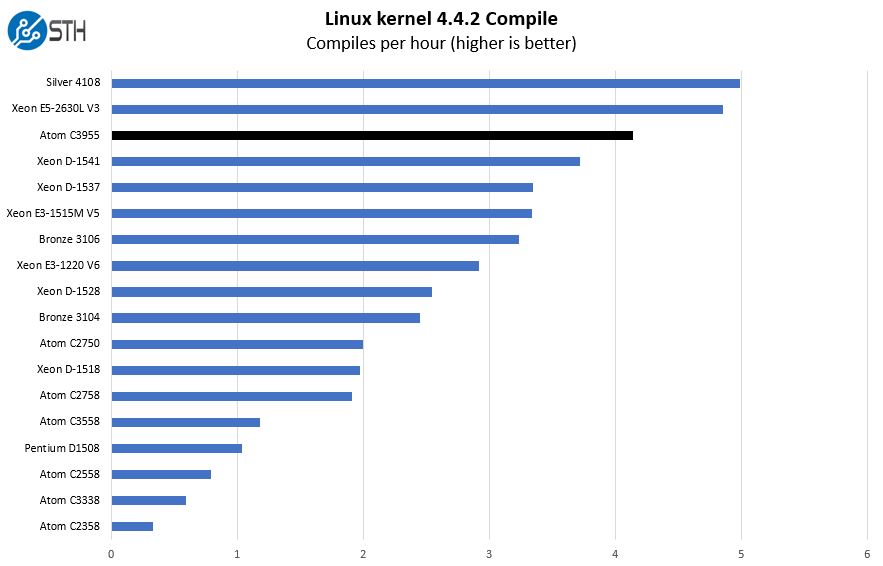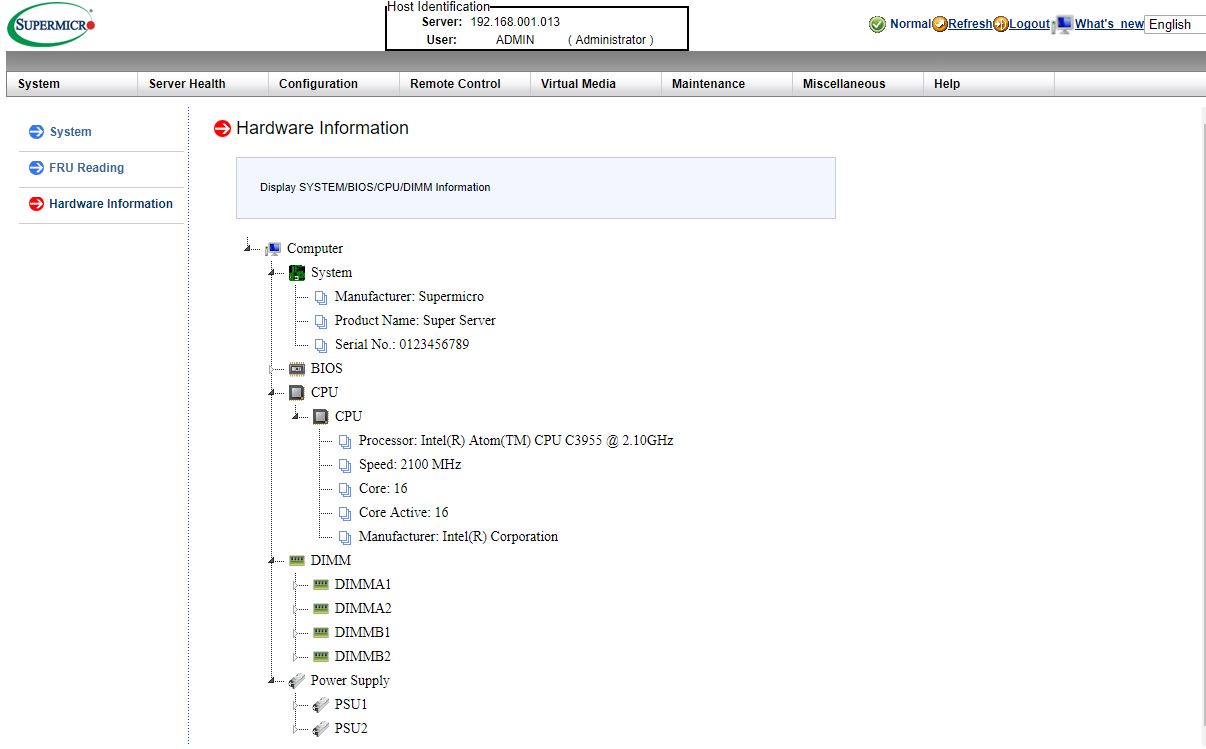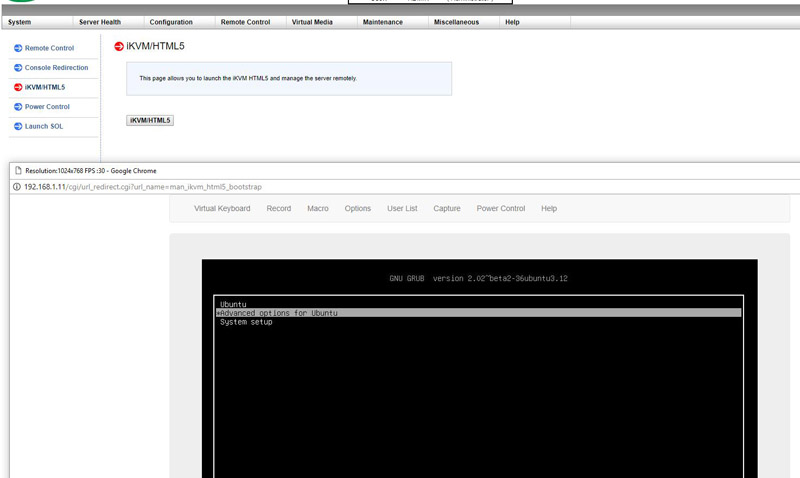Intel Atom C3955 Performance
In terms of overall performance, we published the Intel Atom C3955 benchmarks already. In that piece, we also included the lowest-end Intel Atom C3000 series part, the C3338 so you can get a sense of how the new platform performs compared to the rest of the line. Here is our Linux Kernel Compile benchmark:

As you can see, the new CPUs are over 2x the speed of previous generation parts. Furthermore, the 16 core part can be competitive with some of the higher-power CPUs. For an embedded part, this is a major jump in performance.
Supermicro Management
These days, out of band management is a standard feature on servers. Supermicro offers an industry standard solution for traditional management, including a WebGUI. The company is also supporting the Redfish management standard.

In the latest generation of Supermciro IPMI is a HTML5 iKVM. One no longer needs to use a Java console to get remote KVM access to their server.

Currently, Supermicro allows users to utilize Serial-over-LAN, Java or HTML5 consoles from before a system is turned on, all the way into the OS. Other vendors such as HPE, Dell EMC and Lenovo charge an additional license upgrade for this capability (among others with their higher license levels.) That is an extremely popular feature. One can also perform BIOS updates using the Web GUI but that feature does require a relatively low-cost license (around $20 street price.) That is a feature we wish Supermicro would include with their systems across product lines.
At STH, we do all of our server testing in remote data centers. Having the ability to remote console into the machines means we do not need to make trips to the data center to service the lab even if BIOS changes or manual OS installs are required.
Power Consumption
We did use our Extech TrueRMS Power Analyzer 380803 so these measurements are taken at the PDU in our 120V 15A low power racks. Intel Atom C3000 series systems are often found in remote offices on 120V power so we are using our 120V lab racks for this test, as we did for Xeon D and Intel Atom C2000 series servers.
- Power off BMC only: 4.9W
- OS Idle: 29.6W
- Single Thread Maximum: 34.2W
- 100% Load: 53.5W
These numbers are great. Maximum performance is in the range of an 8 core Xeon D, and at lower power. We should mention that this is with 4x 16GB RDIMMs and all LAN ports lit up to 10GbE speeds. There is an opportunity to shave some additional power off of the platform.
Final Words
When it comes to the top of the line Intel Atom C3000 series compute, this is it. Power wise this platform uses less than an 8 core Xeon D system. The storage platform capabilities with the ability to easily power 12 SATA devices and connect 2x SFP+ and 2x 10Gbase-T ports is awesome in a low power platform.
We did want to touch on pricing. The Intel Atom C3955 (and Atom C3000 in general) pricing is high with a list price of $434. Also, the Intel Atom C3000 series like the Xeon D series, requires an external PHY for 10GbE. On this particular motherboard, having both SFP+ and 10Gbase-T PHYs drives price up. Likewise, as one adds more wires and layers in the PCB to support more SATA devices driving costs up as well. We are going to put the street price of this board is going to be around $700 which is essentially double what a top-end Atom C2000 series motherboard will sell for. The key driver is the CPU cost which is 2.5X what the top of the line compute C2750 cost ($171). Intel is justifying pricing based on the fact that one no longer requires external SAS/ SATA controllers and 10GbE card(s). If we look at something like the Intel C621 v. C624 on the Xeon Scalable PCH side, one goes from 4x 1GbE to 4x 10GbE embedded for $43 ($100-57). We think Intel’s value based pricing is compared to external X550 series NICs (with PHYs) not Intel’s alternative PCH options.
In summary, we think that this is a great platform for networking and storage appliances and lightweight virtualization. The only reservation we have is that one is paying a premium for the lower power consumption and small footprint. For many of our readers, solutions based on the A2SDi-H-TP4F are going to be very exciting once we see retail availability in mid-to-late September 2017.




The Supermicro web page for that motherboard clearly states that the embedded CPU is a C3958, not a C3955. It features Quick Assist, but runs at a 100MHz lower base frequency.
Reference :
https://www.supermicro.com/products/motherboard/atom/A2SDi-H-TP4F.cfm
Coug – we got a version with a different CPU. lscpu output and motherboard numbering are posted in the review.
Great review. Could you please add numbers from ARM microservers offering for comparison?
Can you test if the board is compatible with SmartOS?
Nice review. I don’t see any AVX* features listed in `lscpu`. Can you double check which processors support AVX*? Also, is PCI passthrough now supported with the whole C3000 line? It wasn’t supported on C2000.
Hi Glen – as mentioned after the lscpu output, this is not a supported feature on these CPUs. They are not targeted at AVX workloads.
I would like to see a comparison between the c3000 and the Xeon D15xxN platforms. My use case is networking appliances (firewall / IPS / ids)
Are those u.2 connectors by the internal usb A? Can’t find them in the spec…
SFF-8643 but doing 4x SATA not SAS or PCIe
Is the X557 onboard nics compatible with 802.3bz ?
Supermicro says max RDIMM capacity is 128gb, but Intel ARK states 256gb.
Do you know if 64gb sticks works Patrick?
Can you do a review with this MB on FreeNAS ? Would be great to see the performance, doing a 12 bay x 10Tb NAS + 128Gb of ECC Ram.
Daniel – FreeNAS 11.0u2 does not support the Intel X553 out of the box See: FreeNAS 11.0u2 and Intel Atom C3000 X553 10GbE Testing – it will likely get fixed in a future update and we will revisit at that time.
@Davi have not had a chance to test on 802.3bz. 10GbE is now our low speed network. On the 64GB RDIMM the set we had did not work. Looking to the SM HCL to see if that gets updated with supported 64GB modules in the future.
Is there a board that offers SAS to the drives, known to anyone please?
Really appreciate if anyone can give directions!
It does not. Only SATA.
Any word on SmartOS?
Does anyone use SmartOS? It is garbage that HPE picked up. We try it every year for clients. Every year we find it unusable.
Can you do a comparison for video transcoding using Plex or such vs the Xeon D-15xx platform?
Would love to see some C3858 coverage to be honest, anything planned?
Seconded request for transcoding benchmarks vs Xeon D, and more transcoding benchmark results in general.
+1 for transcoding benchmarks vs Xeon D, and also a review of the C3750 may be really cool (versus the C2750, as it is it’s small brother).
+1 for SmartOS compatibility testing…
SmartOS testing please
hi,
Can this Atom run SCCM/SQL/ GNS3 with no probleme?
As part of a school thesis for research I’ve got to search sites with relevant information on given topic and provide them to teacher our opinion and the article. Your post helped me a lot. This is my first time see here. From the tons of comments on your articles, I guess I’m not just one having all the enjoyment right here! I just couldn’t leave your website before telling you that I truly enjoyed the best high quality articles you present for your visitors? Will be returning again frequently to check up on brand new posts.
Can the heatsink be replaced with an active fan for non-rack use? Is it a standard mounting pattern/etc?
Where to buy this ? online
I’m wondering if it works in UnRaid.
What the hell is that date format: “2017-26-08”?
Yegads, trust Americans to take a standard that is unambiguous everywhere (ISO-8601), and completely screw it up.
Hi,
do you know which 64 GB ECC RAM modules work with this motherboard?
Does it support LRDIMM?